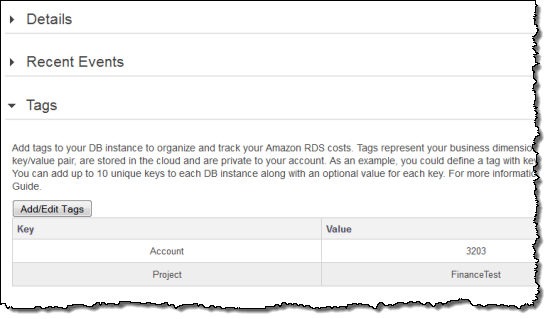AWS News Blog
Tags for Amazon RDS Resources
|
|
You can now use tags to organize your Amazon RDS resources. Also, as I have noted in my companion blog post, you can reference these tags in IAM policies in order to manage access to RDS resources and to control the actions that can be applied to the resources. You can even use the tags to track costs by grouping expenses for similarly tagged resources.
Taggable Resources
You can now tag every type of RDS resource (prior to this release you could only tag DB instances):
- DB instances
- Reserved DB instances
- Read replicas
- DB Event subscriptions
- DB option groups
- DB parameter groups
- DB security groups
- DB snapshots
- DB subnet groups
As is the case with other taggable AWS resources, you can create up to ten tags per resource. The tag names and values are simply character strings; AWS does not apply any meaning to them. Tag names can be from 1 to 128 Unicode characters in length. Tag values can be from 1 to 256 Unicode characters in length. Consult the RDS documentation for additional information on the set of acceptable characters for names and values.
Applying Tags
You can apply tags from the AWS Management Console, the Amazon RDS API, and the Amazon RDS Command Line Interface (CLI).
Here’s a screen shot of the console interface for viewing and adding tags:

If you are using the Command Line Interface, check out the rds-add-tag-to-resource command. From the API, use the AddTagsToResource function. In either case, you’ll need to know how to construct Amazon Resource Names (ARNs) for the newly taggable resources. Visit Constructing an Amazon RDS Resource Name for more information on this topic.
To learn more about this new feature, read Tagging Resources in the RDS Documentation.
— Jeff;
